The wiki is lacking in content. You can help by creating a new article. See the to do list for more ways you can help.
New user registration has been restored. Thank you for your patience.
Welcome Indie Wiki Jammers! Check out here for info on the jam
Final Fantasy Mystic Quest
| Final Fantasy Mystic Quest | |
|---|---|
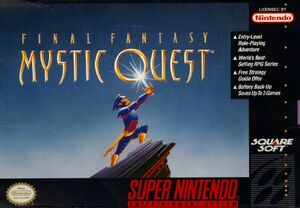 North American box art | |
|
ファイナルファンタジーUSA ミスティッククエスト | |
| Developer(s): | |
| Publisher(s): |
Square (North America, Japan) |
| Platform(s): | |
| Release date: |
Super Nintendo: |
| Genre: |
Role-playing game |
| Modes: |
Single player |
| Ratings: |
ESRB: E (Virtual Console rerelease)[1] |
- Not to be confused with Final Fantasy Adventure, which is named Mystic Quest in Europe.
Final Fantasy Mystic Quest, known as Mystic Quest Legend in Europe, is a role-playing video game for the Super Nintendo Entertainment System. It was first released in America in 1992 and then in Japan and Europe in 1993. It was both developed and published by Square, although Nintendo published the game in Europe. In America, the game sold for an MSRP of US$39.99.[2] Besides the usual instruction booklet, every boxed copy of Final Fantasy Mystic Quest consisted of a detailed map of the in-game world and an offer to earn a free strategy guidebook, which could be done by filling in a form and mailing it to Square before January 31, 1993.
Final Fantasy Mystic Quest is a beginner-friendly RPG that was designed to appeal to western audiences. As such, the game is titled Final Fantasy USA: Mystic Quest in Japan. Final Fantasy Mystic Quest also has some elements from action-adventure titles. While technically the first Final Fantasy game released in Europe, the game was not branded as a Final Fantasy game there, like Final Fantasy Adventure, which is similarly titled Mystic Quest in Europe.
The game stars a young man named Benjamin, who goes on a quest to reclaim a set of four stolen crystals that each determine the state of the world's four elemental powers: earth, water, fire, and wind. Final Fantasy Mystic Quest differs from games in the main Final Fantasy series in that it does not have random encounters, save points, or the ability to manually equip weapons, armor, and other equipment to the characters. Final Fantasy Mystic Quest's plot also has a lack of depth.
In 2010, Final Fantasy Mystic Quest was ported to the Wii's Virtual Console in both North America and Europe. Prior to the Wii Shop Channel's closure, the game could be bought for 800 points. In 2014, the game was ported to the Wii U's Virtual Console, although only in Japan.
Story[edit]
| This section uses content from Wikipedia (view authors), and falls under the compatible Creative Commons license. |
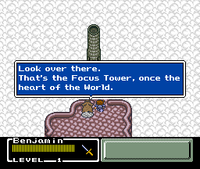
The game opens with Benjamin climbing the Hill of Destiny. While exploring, his village is destroyed in an earthquake. As Benjamin is climbing the Hill, he meets White, a mysterious old man who charges him with fulfilling the knight's prophecy. Although initially in disbelief, Benjamin accepts the role and White shows him the Focus Tower, supposedly the center of the World. After defeating a Behemoth, Benjamin follows White to the Level Forest, where he is tasked with recovering the Crystal of Earth. Proceeding to the decaying village of Foresta, he meets with an axe-wielding girl named Kaeli, who agrees to help Benjamin if he can help her rid the Level Forest of monsters. Kaeli is ambushed and poisoned in the process, and her mother informs Benjamin of the Elixir and where it can be found. Benjamin's search for Elixir to heal Kaeli brings him to Bone Dungeon, where he is aided by a treasure hunter named Tristam in succeeding dual purposes: not only does Benjamin get Elixir from Tristam to heal Kaeli, but he defeats one of the four Vile Evils, Flamerous Rex, to free the Crystal of Earth and in turn restore life to Foresta. Tristam leaves and Benjamin heals Kaeli.
Benjamin is told that Aquaria is in danger, and is in need of help. He is told by White and various others that he should see Spencer. He is told that a girl named Phoebe can help him as well. After proceeding through the first stage of the Focus Tower, and arriving in the province of Aquaria, Benjamin locates Phoebe, and learns that Spencer is trapped underground by thick ice floes. Phoebe needs the wakewater, which is said to be able to help free Aquaria. Benjamin and Phoebe head to the Wintry Cave and defeat a monster to obtain the Libra Crest. Using this crest to enter Life Temple from the Libra Temple, they find that the source of the wakewater has dried up. Finding White in the back of the Life Temple, they find that he holds the only bag of wakewater, and to use it on the plant in the center of town. Back in Aquaria, they find that the wakewater does not work, and reviving the crystal is the only thing that will save Aquaria and Spencer. They head off for the Ice Pyramid and defeat the second of the Vile Evils, the Ice Golem. The Crystal of Water is saved, and Benjamin and Phoebe head back to Aquaria. They find the town is now like Foresta after the crystal is revived there and Spencer is back and digging his tunnel to save Kaeli's father Captain Mac. Upon leaving, Spencer hands the Venus Key to Benjamin, and tells him to head for Fireburg.
Benjamin arrives in the Focus Tower to find White again, who tells him to find Reuben, and disappears. Benjamin heads for Fireburg, and finds Reuben, who joins him when Benjamin promises to help free Reuben's dad, Arion. Upon finding Tristam in the Inn who gives Benjamin the Multi-Key, they find the coward who left Arion in the mine in a locked house. He teaches Benjamin how to throw the bombs and says that it will free Arion. Benjamin and Reuben then proceed to the Mine and free Arion. Arion tells some tales of how the Crystal of Fire has gone berserk, and Reuben goes off with Benjamin to the Volcano to stop the Dualhead Hydra from draining its power. After defeating it, the Crystal of Fire's power is restored, and Benajmin and Reuben decide to head to Windia. Along the way, Reuben is ambushed by monsters and falls off the rope bridge. Tristam comes along and helps Benjamin cross the bridge, but they are stymied by a tree who won't talk to them. Tristam says that there is a gal in Foresta who can talk to tree spirits, and the two drop in on Aquaria where Kaeli was trying to find Spencer. Benjamin and Tristam go down into the tunnel and find Spencer, who tells Tristam of a great treasure. They leave, and Phoebe plants a bomb that collapses a tunnel Spencer was building. She leaves to tell Spencer what happened, and Benjamin takes Kaeli to the Alive Forest to talk to the dormant tree spirit. He tells them that he will take them to Windia if they kill the monsters dwelling within him. After they do so, the tree spirit takes them to Windia.
Upon arriving in Windia, Benjamin and Kaeli find Otto, whose daughter was caught in Pazuzu's Tower when the winds from nearby Mount Gale knocked out his Rainbow Road. The only way the road works is when there is no wind, so Benjamin and Kaeli proceed to Mount Gale and stop the wind by defeating a powerful monster at the top. After returning to Windia, Otto powers up the Rainbow Road and the two adventurers proceed to Pazuzu's Tower. After giving chase, they corner Pazuzu and defeat the fourth Vile Evil and restore the Crystal of Wind. Norma is reunited with Otto, and Kaeli stays to take care of her. Reuben shows up and after a series of long events Captain Mac is rescued. Reuben falls down because of the injury sustained on the Rope Bridge, and Phoebe joins Benjamin instead.
White tells Benjamin an ominous addendum to the prophecy: "the one behind the four is darker than the night, and rises midst the land." It becomes known that the Dark King is the true source of evil. Benjamin thus sails to Doom Castle to confront the Dark King, who threatens to enslave Benjamin along with the rest of mankind. The Dark King claims that he wrote and spread the prophecy Benjamin had followed throughout his quest. Once the Dark King is defeated, White congratulates Benjamin and reveals that he is the fifth crystal, the Crystal of Light, who was disguised as a human. In the ending, Benjamin is seen still craving adventure, and he borrows the ship from Captain Mac as his friends gather to wish him off. While sailing, Tristam makes a surprise appearance.
Gameplay[edit]
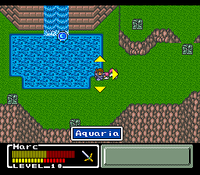
When the game boots up, the title screen is immediately shown. It starts with a "Q" spinning before falling into place, followed by the rest of game's title and its copyrights appearing on screen. There is a gap between the title and copyrights that shows an animated sequence of the crystals bouncing around. If no button is pressed for a while, the game enters "Demo Mode,"[3] in which various scenes of the game are shown. Once the player exits the title screen, they can select from three save slots to start either a new or an existing game. Whenever a new slot is selected or if there are no existing data files, the player must input a name, which is applied to Benjamin, before they can begin. The party consists of only up to two members, and Benjamin is always one of them.
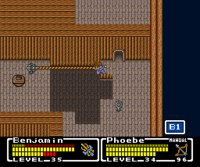
Benjamin is the only character who can be controlled outside of battle. Like earlier Final Fantasy titles, Final Fantasy Mystic Quest is presented in a top-down perspective. Unlike earlier Final Fantasy games, the World cannot be freely explored. Instead, Benjamin travels along set paths from one pictorial icon to the next. Whenever Benjamin is standing on an icon, at least one blinking yellow arrow appears on screen, and each arrow indicates a direction in which Benjamin can move. However, if an arrow is gray, it means that Benjamin cannot take that path yet, and has to complete a specific task, such as clearing a dungeon, for that path to become available. Whenever Benjamin stands on an icon, the player can press the A Button to have Benjamin enter that area. These areas include towns, dungeons, and optional Battlefields.
The mechanics borrowed from action-adventure titles include Benjamin having the ability to jump and use weapons anywhere outside of battle except the main World hub. The weapons can play an active role in exploration. Benjamin can chop down trees with an axe, detonate bombs to open sealed doorways, or use a grappling hook to cross wide gaps.
There are fewer weapons, armor, and items than in the main Final Fantasy series' titles. Unlike other Final Fantasy games, characters cannot be manually equipped with armor, and a newly acquired armor instead replaces a character's current equipment. Similarly, some weapons serve as upgrades over an earlier weapon, which become unusable once they have been upgraded. Benjamin uses four types of weapons: swords, axes, bombs, and claws. The player can press the L and R buttons to cycle through Benjamin's available weapons.
Unlike earlier Final Fantasy titles, there are no random encounters with enemies (except in the Ice Pyramid) or the World itself. Benjamin and his partner have a choice to approach the enemy and engage it in battle. There are several instances in which an enemy blocks a path, so Benjamin and his partner must fight it in order to progress.
Magic is not learned by designated spellcasters through experience. Instead, Benjamin acquires magic spells through treasure chests or as a reward for clearing out certain Battlefields. The magic spells that each of his partners can use are predetermined. There are three types of magic: White Magic, Black Magic, and Wizard Magic. The system of spellcasting is similar to original versions of Final Fantasy; rather than using magic points to draw upon for supplying magic, spells are used according to a set number. The allotted number for each type increases as a character levels up. Wizard Magic, being the most powerful, has the lowest allotted number, and White Magic has the highest number. Magic spells cannot be upgraded like in other Final Fantasy titles.
Like spells, the effect of items also increases as the characters level up. Both the Heal spell and Heal Potions act as a cure-all for status ailments. Similarly, both the Cure spell and Potion restore HP; the former usually restores most of a character's HP while the latter only restores a fraction of it.
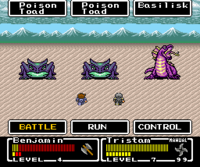
Battles are represented in dungeons as stationary enemy sprites on a static background. When Benjamin engages with an enemy, the game transitions to a battle screen, which presents a window-based menu with three commands to choose from: Battle, Run, or Control. The battle system relies on conditional turn-based combat in which the characters and enemies cycle through rounds in battling each other, and the fastest character gets to have the first turn. The battle screen always shows enemy sprites as being larger than the party members, despite the enemies being further away from the game camera. Choosing the Run command allows the characters to exit the battle, although this cannot be done during boss battles or if a character is paralyzed. Choosing Control toggles between the ability to either have the player decide on a character's actions or to have the game do it automatically.
If the player chooses the Battle command, they are presented with a submenu of four more options: Attack, Spell, Item, and Defense, each having a self-explanatory purpose. Selecting the Spell command allows the player to cycle between a White, Black, or Wizard Magic spell for each character to use. Each type of magic has four different spells. The Item command allows the player to use an item. Selecting Defense causes a character to defend themselves from an enemy's attack during the turn, causing them to take less damage from it.
A character's health points are represented by an incremental health bar, although the player can display it as traditional numerical fractions. If Benjamin and his partner lose all of their HP, the game is over, but the player is given the option to restart the battle, although the main character's attack power may decrease as a penalty. A character's performance in battle is determined by statistics for vitality, attack power, defensive capabilities, speed, magical prowess, accuracy, and evasion. Benjamin's statistics are driven by experience points (EXP) gained from winning battles, which accumulate until he levels up, causing the EXP counter to reset. Defeating all enemies in a battle also earns Benjamin gold pieces (GP), which he can use in towns to buy weapons, armor, and items.
In Battlefields, Benjamin and a partner can fight ten groups of enemies for either an item reward, or a large amount of either GP or EXP. Once a Battlefield has been cleared, it cannot be replayed.
The player can save from the main menu at any time unless a battle is active. Pressing the X Button quickly takes them to the save menu.
Characters[edit]
Player characters[edit]
- Benjamin - The main protagonist and the knight foretold by the ancient prophecy. He uses a variety of weapons and every spell, and is the only character who can gain experience points.
- Kaeli - A spirited girl who lives in Foresta. She is poisoned after an encounter with a Minotaur, but recovers to help Benjamin later on. She uses Axes as her weapon, and gives one to Benjamin.
- Tristam - A Ninja treasure hunter who often refers to Benjamin as "kid". Tristam is the only character who has his own theme music. He uses replenishable Shurikens as his weapon.
- Phoebe - A healer who lives in Aquaria. She joins Benjamin a few times, including in the final dungeon. Phoebe used the Cat Claw as her weapon before giving it to Benjamin, after which she uses the Bow of Grace, which uses a replenishable supply of arrows.
- Reuben - An armored youth living in Fireburg. He joins Benjamin to rescue his father, Arion, and to acquire the Crystal of Fire. Reuben uses a Morning Star as his weapon.
Non-player characters[edit]
- White - An old man who constantly appears to give Benjamin hints about his destiny and where to go next. He rides a cloud everywhere as his means of transportation.
- Captain Mac - He is Kaeli's father. Mac owns a boat that has disappeared at sea and needs to be recovered.
- Spencer - An elderly inventor and explorer living underneath Aquaria. She is the grandfather of Phoebe.
- Arion - He is Reuben's father. Arion has been trapped in Fireburg's Mine and needs to be rescued.
- Otto - A mechanic living in Windia who built the Rainbow Road machine. He asks Benjamin to rescue his daughter from Pazuzu's Tower.
- Norma - She is Otto's daughter. Norma is trapped in Pazuzu's Tower, and must be rescued by Benjamin.
Bosses[edit]
Mini-bosses[edit]
These creatures, after being encountered for the first time in the story, are encountered later as weaker, common foes.
- Behemoth - A giant bull that attacks Benjamin at the start of the game after being unleashed from the earth by an earthquake. He has a weaker form known as Gorgon.
- Minotaur - A giant man with the head of a bull, he is an evil woodsman, rotting away the earth's trees and poisoning the land. He has a weaker form known as Minotaur Zombie.
- Squidite - A giant squid that makes use of electrical and fiery attacks. He guards the Libra Crest in the Wintry Cave. He has a weaker form known as Phanquid.
- Snow Crab - A giant crab made of ice and snow that uses cold attacks. It guards the passage from Falls Basin to the Ice Pyramid. He has a weaker form known as Freezer Crab.
- Jinn - A fire-type genie like character with one eye and a huge sword, has taken over the mine. He has a weaker form known as Iflyte.
- Medusa - A woman guarding the Volcano. Like her Greek mythology counterpart, Medusa has snakes for hair, and can petrify a party member. She has a weaker form known as Stheno.
- Gidrah - A multi-headed Chimera which has taken over the world's largest tree and laid waste to the insides of it.
- Dullahan - A headless knight riding on the back of a headless horse. He serves Pazuzu, and has a weaker form named Thanatos.
Vile Four[edit]
The four major bosses are the Vile Four, who are a group of monsters that have been draining the power of the crystals. The Vile Four serve under the Dark King, who wishes to cover the world in misery and famine. By defeating the Vile Four and recovering the crystals, balance is restored to another element. At the end of the game, Benjamin must ascend Doom Castle, at the top of which the Dark King resides. On each of the Doom Castle's floors, Benjamin must defeat a more counterpart of each of the Vile Four's members.
- Flamerus Rex - A giant, zombie Tyrannosaurus rex that is encountered as the boss of Bone Dungeon. He is the undead ruler of the Crystal of Earth. Flamerus Rex causes destructive earthquakes, one of which is the catalyst for the beginning of the game. Has a double in the Doom Castle called Skullrus Rex. Being an undead enemy, Flamerus Rex can be instantly defeated from the Life spell.
- Ice Golem - A giant, armored barbarian made out of blocks of ice. He is encountered in the Ice Pyramid, and has turned the world's water into sheets of ice and covered the land in thick blankets of snow. When he is injured, Ice Golem begins melting into a puddle. He has a double in the Doom Castle called Rock Golem.
- Dualhead Hydra - A two-headed dragon encountered at the Lava Dome. He is responsible for the world's volcanoes to erupt violently and destroying towns. Dualhead Hydra has a double in the Doom Castle called Twinhead Wyvern.
- Pazuzu - A giant, demonic eagle dressed in finery and jewels. He is encountered in his own tower, Pazuzu's Tower. Pazuzu is the chief lieutenant to the Dark King and the only one of the Vile Four to have a defined personality. He uses the Crystal of Wind to cause gale force winds to tear through the world. He has a double in the Doom Castle called Zuh.
- Dark King - A wicked king who represents the ultimate evil. He is a green-skinned man dressed in red robes and a crown. The Dark King the ability to change his form, which is seen during the final battle; when enough damage has been inflicted upon the Dark King, he throws off his robe to reveal eight arms, each clutching a different weapon. Further damage causes him to transform into a giant tarantula with a grinning, bearded, demonic face. His fourth and final stage is akin to the tarantula stage except he has spidery limbs instead of tentacles.
Locations[edit]
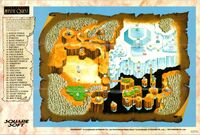
The entirety of the game takes place in the Mystic Quest World (named World in the game), which is divided into four quadrants, each consisting of a region. The welfare of each region is determined by the state of their respective crystal. Regions missing their crystal are plagued by decay, climate change, or other natural disasters. When Benjamin recovers a crystal, its associated region returns to normal.
- Foresta - Forested area that prospers under the Crystal of Earth. Prior to being restored, it is wilting and in decay.
- Aquaria - Town on a large lake that prospers under the Crystal of Water. Prior to being restored, the town is frozen over.
- Fireburg - City on a mountainside that prospers under the Crystal of Fire. Prior to being restored, the town suffers from perpetual earthquakes.
- Windia - Cliffside village that prospers under the Crystal of Wind. Prior to being restored, the town suffers from crippling gales.
- Focus Tower - A giant tower that stands in the center of the world. Passages and doors inside the tower lead to the other four areas of the world.
Development[edit]
- "The action/adventure players... are larger in numbers and the demographic is different. They tend to be younger and like the idea of jumping straight into the action with a sword in their hands; it's an empowerment issue - you get to go out there, start whacking things and it feels good! With the more traditional RPGs, it takes a good 15 or 20 hours of playing before you're finally hooked."
- —Ted Woolsey, Super Play Magazine (September 1994 issue)
Although designed by one of Square's development teams in Japan, Final Fantasy Mystic Quest was specifically geared for the United States' market. At the time, console role-playing games were not a major genre in North America; Square thus attempted to broaden the genre's appeal through Final Fantasy Mystic Quest.[4] Square's executives cited the alleged difficulty of role-playing games as the reason Americans shied away from them, and eased the difficulty level by tweaking various aspects of the main series' gameplay.[4] Square even worked with their American offices to ensure that the game would be accessible to children.[5]
Final Fantasy Mystic Quest has numerous similarities to Final Fantasy Legend III. It has a very similar battle system, graphical interface, and dungeon system. The game even reuses the jumping mechanic from Final Fantasy Legend III. Many of the icons — from caves to the enemy sprites — are a color-upgraded version of Final Fantasy Legend III's sprites. Besides allowing for computer-controlled allies, the game did away with random battles, complicated storylines, and text-based menus. To appeal to the perceived tastes of North American audiences, which gravitated towards fast-paced games, Square included action-adventure game elements. Ted Woolsey stated that Final Fantasy Mystic Quest was one of the easiest games he had to translate, due to the game's small size.[6]
References[edit]
- ^ https://www.esrb.org/ratings/29275/FINAL+FANTASY+MYSTIC+QUEST/
- ^ "The History of Final Fantasy" (Final Fantasy Mystic Quest). GameSpot (archive.is).
- ^ Final Fantasy: Mystic Quest instruction booklet, page 6.
- ^ a b Ogopogo Examiner issue 2
- ^ (Fahs, Travis) "IGN Presents the History of Final Fantasy". IGN (Wayback Machine). Published June 26, 2009.
- ^ "Bob Rork Woolsey Interview". Chrono Compendium (Wayback Machine).